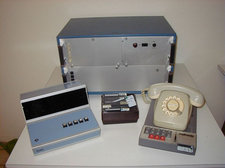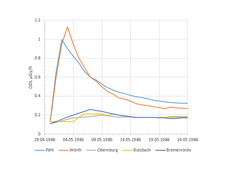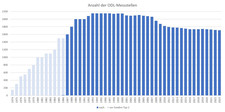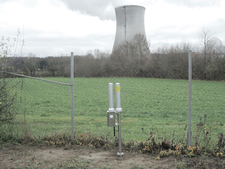-
ODL-INFO
Subnavigation
What's the purpose of an ODL measuring system?
- After the German Federal Office for Civil Protection for the first time elaborated plans at the end of the 1960s on how to rapidly collect measuring data in the event of contamination by radioactivity, the prototype of a measurement transmitter was accomplished in 1973.
- By 1984, a total of around 1,200 measuring points were in operation. In 1986, ten of them had been fitted with a then-advanced type of gamma probe which were sufficiently sensitive to register the increased local dose rate in Germany caused by the Chornobyl reactor accident.
- The BfS has been operating the ODL measurement network since the 1990s. It continuously develops measurement and transmission technology.
- Role of the measuring network: Determine the level of radiation in the event of a nuclear attack
- New role of the measuring network: Monitoring natural radiation
- The Federal Office for Radiation Protection takes over
- Developmental Milestones
At the end of the 1960s the German Federal Office for Civil Protection for the first time elaborated plans on how to rapidly collect measuring data in the event of a contamination by radioactivity. This must be seen against the background of the Cold War: Germany feared a nuclear attack by the Warsaw Pact states. At that time the Federal Republic of Germany had 10 so-called "warning offices" (Warnamt). In the state of defense it was their task to give warning of dangerous situations to the civilian population.
Each of these warning offices operated four or five measuring stations where the existing local dose rate within a range of 0.1 microsieverts per hour to 2 sieverts per hour could be determined with the help of a Geiger Müller tube. The sensitivity of the probes was chosen to show significantly increased levels of radiation, but it was impossible to determine the natural background radiation with this scaling. Someone had to be present at the measuring station in order to read the measuring values directly from the device and transmit them to the responsible warning office.
Role of the measuring network: Determine the level of radiation in the event of a nuclear attack
A nationwide measuring network at ground level was created in order to automatically estimate the existing dangers due to radiation in the event of a nuclear attack. This network made it possible to determine the level of radioactivity and transmit the relevant data to a central unit without the need to send people to contaminated places.

![]() MWS1 – Central unit with display unit, telephone and automatic dialling device
MWS1 – Central unit with display unit, telephone and automatic dialling device
Public tender procedures were initiated in the early 1970s, and the prototype of the first-generation transmitter ("MWS1") was accomplished in 1973.
Beginning of measurements: Requesting data by phone call
The first-generation devices transmitted measuring data via a standard phone line. The system's standard mode was "standby mode".
Once the system received a phone call, it changed to measuring mode and subsequently transmitted the measuring data to the central unit by modem. To this end each measuring station had to be contacted individually by means of a dial telephone and the transmission had to be started by pushing a button. These measuring values were not stored but the data was simply entered into a list.
By 1984, a total of 1,200 measuring stations were in operation. Requesting the data took roughly two minutes per measuring station so that the warning office needed seven to eight hours to have the complete data available.
1980s: from manual transmission to modem service
In the early 1980s the measuring network underwent extensive modernization. The original analogue data transmission system was converted to digital technology. Due to the large amount of single signalisations and measuring data it was necessary to install an electronic data processing system that would process and analyse data and issue forecasts and warnings. The system was called warning service information system or "WADIS".
New role of the measuring network: Monitoring natural radiation

![]() Time series of the increased local dose rate due to the Chernobyl reactor accident at five different measuring stations in Germany
Source: source of data: SSK-Volume 7 / Visualisation BfS
Time series of the increased local dose rate due to the Chernobyl reactor accident at five different measuring stations in Germany
Source: source of data: SSK-Volume 7 / Visualisation BfS
The objective was to use the measuring probes for monitoring the basic level of natural radiation. In 1985 scientists therefore started to develop and test second-generation gamma probes (GS-02). At the time of the Chornobyl (Russian: Chernobyl) accident, only ten measuring stations had been fitted with the second-generation type of gamma probes – advanced technology at that time – which were sufficiently sensitive to register the increased local dose rate in Germany caused by the reactor accident.
In the wake of the Chornobyl reactor accident in 1986, the measuring network was assigned to the field of environmental protection, in particular in 1987 by the provisions of the Precautionary Radiation Protection Act. The measuring data was thus not only used for the purpose of civilian protection but increasingly also for environmental protection. The pure emergency system had turned into a system that would constantly monitor the natural environmental radioactivity.
The Federal Office for Radiation Protection takes over
In 1989, the Berlin Wall came down and the threat of the Cold War ended. According to a decision by the Federal Ministry of the Interior, the warning offices were closed. However, the measuring network operated by the Federal Office for Civil Protection was supposed to be maintained.

![]() Number of ODL measuring stations set up from 1974 to 2023. 1986, only 10 measuring stations were sensitive enough to record the increased ODL in Germany as a result of the Chornobyl reactor accident.
Number of ODL measuring stations set up from 1974 to 2023. 1986, only 10 measuring stations were sensitive enough to record the increased ODL in Germany as a result of the Chornobyl reactor accident.
In July 1997, this task and the complete measuring network were assigned to the Federal Office for Radiation Protection (BfS). The 10 former warning offices were now turned into six local ODL measuring nodes, situated at the BfS sites in Freiburg, Berlin, Munich, Bonn, Salzgitter and Rendsburg.
From analogue modem service to mobile communication
At the time of the takeover, data was exclusively transmitted via analogue modems. After the BfS had taken over, the existing measuring technology was modernised. From 1998 onwards a new system was implemented which offered the option to transmit data via mobile communications. From 2005 to 2015 the old system was gradually replaced by a BfS in-house development. Due to the elimination of analogue landline connections, the measurement network was largely converted to LTE from 2017. Data transmission via satellite is currently also being tested so that the data could be reliably collected even in the event of a large-scale power or provider failure.
Since the BfS took over, the used hardware and software have been constantly refined and adapted to the state of the art. Currently, it takes about 10 minutes for the data to arrive from all monitoring stations. The monitoring stations send their data to the BfS at hourly intervals; in the event of increased measurements, the monitoring stations transmit the data immediately.
The following transmission processes are used:
- Data transmission via fixed network at 54 stations
- Mobile communications at 1,504 stations
- Direct connection via WAN provided by Germany's National Meteorological Service (DWD) at 149 stations
Expansion of the measuring network through spectroscopic probes

![]() Twin-probe for measuring the ambient gamma dose rate in German border area in front of Swiss NPP Leibstadt (left side: spectroscopic probe with intrinsic Lanthanum Bromide detector)
Twin-probe for measuring the ambient gamma dose rate in German border area in front of Swiss NPP Leibstadt (left side: spectroscopic probe with intrinsic Lanthanum Bromide detector)
Since 2018, around 20 measuring points in the vicinity of nuclear facilities have been equipped with additional spectroscopic probes. These probes use lanthanum bromide detectors that record a spectrum of gamma radiation every 10 minutes. With these probes it is possible to determine not only the absolute local dose rate but also the individual radioactive nuclides.
Even with a slightly increased local gamma dose rate, the type of increased radiation can be determined promptly. This allows the early warning function of the measuring network to be improved. In an emergency, these measuring points can provide early information about the nuclide mixture of a release.
Developmental Milestones
The following milestones were reached with respect to data quality and the capabilities to verify recorded data:
- 2003: Implementation of fifth-generation type of probes (GS-05) accomplished. The sensitivity in ten minutes time series was improved and is now roughly 0.02 microsieverts per hour.
- Up until 2014: Replacement of obsolete transmitter technology. In the process, internal automatic testing procedures within the probe were implemented, such as comparing the pulse rates of both counter channels every ten minutes.
- Since 2008: The development of spectroscopic probes is a significant enhancement since these probes cannot only determine the local dose rate but also the contribution of artificial radionuclides. First prototype were installed on the Brocken in the Harz Mountains and on the Schauinsland in the Black Forest in 2008. Since 2018, around 20 probes of this type have supplemented the ODL measurement network.
- Since 2022, the installed components have been subjected to improved hardening at a measuring point, for example to protect against electromagnetic pulses (EMP).
State of 2024.02.27

